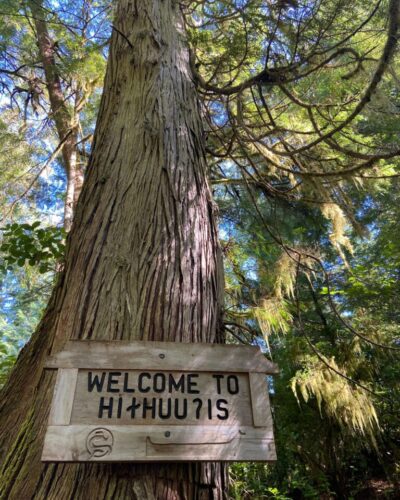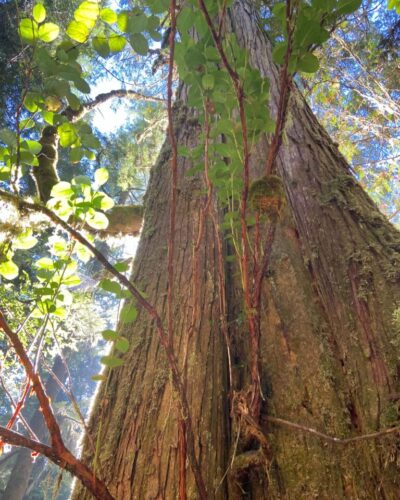How Conservation and Reconciliation are linked
IPCA’s as part of the journey of Reconciliation
Written by Joti Overduin, Outreach Manager | September 29, 2023
The National Day of Truth and Reconciliation is nearing. My thoughts about what it means are rising and falling to the sound of waves, and the smell of the Pacific rainforest – from Tla-o-qui-aht lands and waters, or ha-houlth-ee in the Nuu-chah-nulth language. Most folks are familiar with this area as Tofino, or Clayquot Sound.
The reason that this area has clean waters and healthy rainforests is because of the vision, courage, and determination of the Tla-o-qui-aht First Nation. Almost 40 years ago they declared the first Tribal Park in Canada – Wah-nuh-jus – Hilth-hoo-is, (Meares Island), after it was slated for clear cutting in the 70’s. Because of this declaration, and the years of work that came after, the trees that the Tla-o-qui-aht people have lived alongside, and in deep relationship with long before colonization, are still standing.

I have been able to spend time in this place during this important week of reflection, learning with the Iisaak Olam Foundation at the Clayoquot Campus about Indigenous Protected and Conserved Areas. While here I have had the opportunity to listen and learn from Elders and other Tla-o-qui-aht members, whose lives have been and still are intertwined with the creation of that first Tribal Park in 1984.
In speaking with people here, Elders and others, the impacts of Residential Schools and the other destructive strategies in the Indian Act, a piece of Canadian law meant to control and eradicate Indigenous cultures, continue to be felt deeply by all. Here, and on that same island was where The Christie Residential School was built and run 1900.
At a very young age, children were taken away from their families to attend the school, where they would be treated as less than human, neglected, and even abused. Many died there. The school only officially stopped operating in 1983 – the longest in BC, and only one year prior to the declaration of Wah-nuh-jus – Hilth-hoo-is, Meares Island Tribal Park.
When listening to the Elders and others here, and back home in the Yukon, what is clear is that true Reconciliation is more than a one-day event. While having a national day of recognition is important, it’s only a very small part of the dramatic shifts and changes needed for Reconciliation to have meaning.
Governments have been inconsistent, slow and sometimes outright resistant or obstructive when it comes to taking the deep and meaningful actions and policy changes that would truly support meaningful healing and reconciliation for the harms done, and continue to unfold.
CPAWS Yukon, and other conservation organizations also have a dark and destructive past with Indigenous Peoples that we need to reconcile. Colonially founded organizations like ours have taken part either directly or indirectly in the removal of Indigenous peoples from their lands, or at the very least perpetuated the narrative that people are separate from nature. There is a long history of behaving in a harmfully paternalistic way when it comes to conservation and Indigenous Nations.

The Truth and Reconciliation Commission Report states: “Reconciliation is about establishing and maintaining a mutually respectful relationship between Aboriginal and non-Aboriginal peoples in this country. In order for that to happen, there has to be awareness of the past, an acknowledgement of the harm that has been inflicted, atonement for the causes and action to change behaviour”.
For those of us who are not Indigenous, guests on the lands we live and work in, we can wear an orange shirt, or read an article to learn more about the heart-breaking truths of residential schools. These are important parts of the journey, to see the invisible constructs and harmful worldviews that we live in and amongst.
We also need to understand that our Indigenous hosts and friends live orange shirt day every single day. One important lesson I’ve heard from many different teachers and cultures, is that none of us are separate. We are all connected, and what harms some of us, harms all of us.

Indigenous cultures and teaching recognize this interconnectedness, and have for time immemorial. As we all face the insurmountable crises of climate change, and biodiversity loss, it’s Indigenous peoples that have the knowledge, wisdom and relationships with the natural world we are also a part of that could lead us back from the brink of destruction. Reconciliation doesn’t end with Indigenous peoples, it also needs to happen with the rest of the planet that is being harmed. It’s no coincidence that these are linked.
While this may seem like a challenging path, or one that needs a path to follow, there has already been much work done, like the recommendations from the Indigenous Circle of Experts. Despite governments not always moving fast or steady enough when Indigenous groups give clear recommendations, organizations like CPAWS Yukon and individual Canadians can all help move this work forward. We can support Indigenous Nations in both Reconciliation and Indigenous-led conservation and land guardian initiatives.
If you don’t know already, learn the history of which Indigenous Nations’ homelands you are living and working in, and always include that when you tell others about where you live. Get curious about the people who took care of the land on which you live and what initiatives these Nations are currently pursuing. A simple place to start for a national context is by reading the first two pages of We Rise Together. Open your heart to being comfortable with being uncomfortable, and recognize we need to understand our past to know not only our present, but also a path forward.



